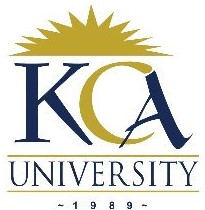 UNIVERSITY EXAMINATIONS: 2017/2018
UNIVERSITY EXAMINATIONS: 2017/2018
EXAMINATION FOR THE DEGREE OF
BACHELOR OF SCIENCE IN INFORMATION TECHNOLOGY/BACHELOR OF
APPLIED COMPUTING/BACHELOR IN BUSINESS AND INFORMATION
TECHNOLOGY/BACHELOR IN INFORMATION AND COMMUNICATION
TECHNOLOGY
BIT1106A OPERATING SYSTEMS
DATE: APRIL, 2018 TIME: 2 HOURS
INSTRUCTIONS: Attempt Question One & ANY OTHER TWO questions.
QUESTION ONE: [30 MARKS]
a) What are the FOUR conditions required for deadlock to occur? Briefly discuss them. (8 Marks)
b) Distinguish between a flat directory and a hierarchical directory. (4 Marks)
c) Describe the following scheduling algorithms
i. FCFS
ii. Round Robin
iii. Shortest Job First (6 Marks)
d) Describe the benefits of a mono-programming operating system. (4 Marks)
e) Describe TWO techniques that can be used to manage disk free space (4 Marks)
f) Describe the two general roles of an operating system, and elaborate why these roles are important.
(4 Marks)
QUESTION TWO: [20 MARKS]
a) Distinguish between the following terms as used in operating system
i. Monitor and Semaphore (2 Marks)
ii. User level threads and Kernel level threads (2 Marks)
iii. Race condition and Critical Section (2 Marks)
iv. Device handler and Direct Memory Access(DMA) (2 Marks)
b) Explain THREE functions of the Kernel in I/O management (6 Marks)
c) Describe THREE mechanisms for interrupting execution of a process (6 Marks)
QUESTION THREE: [20 MARKS]
a) With the aid of a diagram, explain the five process state model. (5 Marks)
b) Identify four locations on which the scheduler might be activated (4 Marks)
c) Describe the operation of semaphores in an operating system. (4 Marks)
d) Discuss the objectives of file management. (7 Marks)
QUESTION FOUR: [20 MARKS]
a) Define three requirements that a solution to the critical-section problem must satisfy. (6 Marks)
b) Describe the differences between symmetric and asymmetric multiprocessing. (4 Marks)
c) Identify THREE advantages and THREE disadvantages of multiprocessor systems. (6 Marks)
d) Briefly explain the concept of swapping. (2 Marks)
e) When is a swapper invoked. (2 Marks)
QUESTION FIVE: [20 MARKS]
a) Using diagrams discuss the FOUR structures of Operating systems. (8 Marks)
b) Explain the importance of inter-process synchronization (4 Marks)
c) Distinguish between static and dynamic memory allocation schemes and explain how each scheme
wastes storage. (6 Marks)
d) Briefly explain the objective of computer security. (2 Marks)
